Funded by Auckland Zoo Conservation Fund (2016- present) and NZMCA (2020-2021)
The Matukituki Valley in Mt Aspiring NP is considered an important site for kea research with significant time and resources having been invested in the area since 2016. Both the West and East Matukituki Valleys have been surveyed by the KCT since January 2016 and up until February 2019, no nests or breeding activity had been recorded and only one fledgling sighted (when 6 fledglings were caught and banded). The reason for the lack of documented breeding activity appears to be a result of high predator numbers re-invading the area as well as adult mortality during pest control operations.


Understanding how predators are impacting resident kea and breeding success is crucial for ongoing recruitment in the valley. As such from the end of 2019 onwards this project will aim to:
i) ascertain sub-adult and adult kea survivorship in the Matukituki Valleys;
ii) monitor kea breeding success in the study area and
iii) understand predator interaction and risk to a population of kea, east of the main divide.
This project will provide important information to support the larger DOC predator impact study on kea populations east of the main divide.
Summary of Outcomes 2025
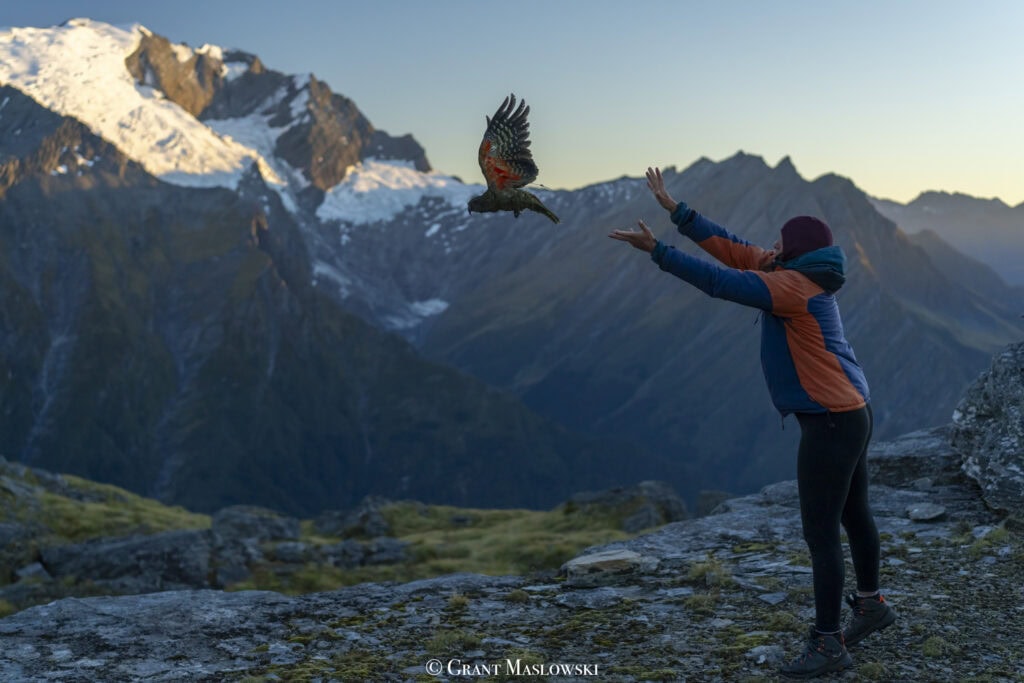
Catch summary. A summer survey catch trip was carried out over 8 days (20-27th February 2025). A total of 29 new kea were caught and banded (plus 3 recaptures). Of these, eight were adults (two females) and three sub-adults ( two of which were female which is rare). The rest of the birds were either fledglings (four) or juveniles (17). Four transmitters were fitted to the females to enable follow up nesting monitoring.
This brings the total number of kea banded in the Matukituki Valleys since 2016, to 254 with 46 adults also fitted with transmitters to assess breeding activity and surivorship.
Compared to previous years, there was a notable reduction in the number of fledglings caught. Despite catching usual numbers of other age groups, the number of fledglings seen and caught was much lower than usual. This may be because there was limited nesting success over spring. It appears that two of the monitored nests failed due to being displaced by possums. Possums and possum sign were noted at every catch site during the survey.

Nest monitoring summary.
As of the end of 2024, three females had been recorded as attempting to breed - Erin Marshall, Grand Master and Harakeke. At least two of these failed due to possum interference/ possible predation.
Grand Masters nests failed at the egg stage, likely due to possum predation (possums were seen interfering with the nest on multiple occasions). Erin Marshall had two healthy chicks through to the 26 November nest check, however review of nest footage in early 2025 showed no sign of the chicks fledging, and recurring visitation by possums. Predation by possums is therefore considered likely. Harakekes nest was heard to contain at least one chick when found during the 5th November nest check, however it was not possible to see into the cavity to see number or development stage due to access issues. Once camera footage is reviewed for t his nest, we will know whether chicks managed to fledge or not.
Summary of Outcomes 2024
Catch summary. A summer survey catch trip was run in the West Matukituki over 5 days (6-10 March 2024). A total of 26 kea new kea were caught and banded. Only three of these were adults (two females who were fitted with ET transmitters), the rest were young fledglings or juveniles. One of the two birds reported in mortality from last reporting period, Mike J, was found dead. Body was too decomposed to ascertain cause of death. The other bird, Stargazer, has yet to be found.
This years summer catch trip was filmed by Auckland Zoo with Jasmine Rabaud helping out with catching and banding of kea.
Transmitter status. Twenty-five transmittered birds were followed up on during this period. Signals searched for include mortality mode – double beep, normal activity - 20ppm and nesting - 40ppm.
Six ground tracking events (tracking, nest monitoring and mort recovery) – 12 Oct 2023, 31 Oct 2023, 7-9 Nov 2023 (mort recovery), 14 Dec 2023, 12 Jan 2024, 8 March 2024, 24-26 July 2024, 5- 7 Sep , 23 Sept and 25 Sept 2024.
Three tracking flights were carried out during the project period (20 Oct 2023, 22 Nov 2023, 4th June 2024).
Mortality mode - Seven kea were found to be in mortality mode during this period (Lochie, Mike J, Stargazer, TB3, Skyscraper, Hughee and Davis). The following birds/transmitters were recovered; Skyscraper (ditched transmitter only), Mike J and Hughee (both deceased). A banded kea without a transmitter (Walter) was also recovered dead, most likely from lead poisoning.
Camera trap summary. Four full camera checks were carried out during this period over 12-13 days in Oct 2023 (East Matukituki), Jan/ Feb (both valleys), April (both valleys), June/July (both vallies) and Aug/Sept (West Matukituki).
In comparison to last year, pest numbers were signficantly higher. Cat sightings were down in the East M (8 vs 18) but up in the West M (18 vs 6), mouse numbers were significantly higher in both valleys (4869 vs 983 last year) as were rats (3204 vs 776), stoats (503 vs 154) and possums (750 vs 348). The sharp increase in pests is likely due to the 2022 beech mast.
Kea numbers were down in the East M (20 vs 45) and up in the west M (462 vs 440).
Nest monitoring summary. Final visits to the two active nests on 14 Dec 2023 (Susan M and Harakeke) showed a total of 3 fully feathered chicks. Some pest incursions were caught on camera at Susan Ms nest (mouse, rat, possum and stoat). A follow up visit in January 2024 showed no sign of chicks and no indication from nest cameras of predation so it is likely they successfully fledged. Erin Marshall's tx went from incubation to normal mode suggesting a failed nesting attempt as no chicks seen.
Nest visits in 2024 showed two of four adult females tracked went into incubation mode (Erin Marshall and Grand Master). The known 2022 and/or 2023 nests of females with flat txs (Susan M and Kia Kaha) were visited periodically but were not active nor was Harakekes. At last visit end of September, Grand Master was seen incubating three eggs. Erin Marshalls nest, which is located high up in the snowline, has not yet been found.
Summary of Outcomes 2023
Catch summary. A summer survey catch trip was successfully run over 5 days (23-27th Feb 2023) resulting in 24 kea captured (including 4 recaptures), banded and transmitters fitted to three adults (1 female and 2 males). This brings the total number of birds banded since the start of the project to 199 and transmittered birds to 40 with 15 still in active mode across the year.
Transmitter status. Tracking of transmitters was carried out eight times across the year (4 tracking flights and 4 on foot by tracking teams) in February, April (flight), May, September (flight), October (flight) and November(flight).
September outcomes: A tracking flight carried out 8 September 2023 returned active signals for 16 transmitters with 2 of these in breeding mode (Susan M and Harakeke). No signal was picked up for 9 transmitters (3 of these have had no signal recorded for over a year (Kia Kaha (last physically sighted 10 Oct 2022), Keapatra and Inigo Montoya) which may likely indicate flat batteries) and 2 transmitters returned a mortality pulse (Mike J and Stargazer who both last returned active signals on the 8
th Sept 2022). A follow up foot tracking trip (26 Sept) noted two changes in previously active signals – Lochie was now emitting a mortality signal and Erin Marshall was emitting a breeding pulse. Kia Kaha was sighted alive.
November outcomes: The last flight of the year returned active signals for 13 transmitters. No signal was picked up for 7 transmitters although one of these (Susan M) was still attending chicks. 4 transmitters were in mortality (the previous 3 plus Skyscraper).
Camera trap summary. Five full camera checks were carried out in January, March, June, September and December 2023. All SD cards and batteries were changed and 6 non-working cameras replaced during the March check. All species visitations were graphed (where the number of hours per species indicates number of hours where there was a visit to the camera (not every single trigger event by the same species that hour)) and mapped.
Nest monitoring summary. A tracking flight on the 8th September picked up two females in breeding mode (Susan M and Harakeke). Two follow up trips on foot were carried out in September to locate the nests– Susan M was seen with one small fluffy chick in her nest and Harakeke was seen with two eggs. Nest cameras were set up to record activity outside nest. An additional nest signal was recorded from Erin Marshall late September and a general location noted. A follow up check 1st November found Erin Marshalls nest had been abandoned while Harakeke was sighted with one downy chick and one small unhatched egg. Susan M had two chicks in her nest with adult plumage on their heads starting to show through the down.
Summary of Outcomes 2022 (February - April)
Catch summary. The KCT team spent 10 days in both the East and West Matukituki Valleys late February, resulting in a further 79 kea banded and 20 new transmitters attached to adults (7 eggtimers to females and 13 long life transmitters to males). This is an extraordinary outcome which we hope will allow us to follow up on breeding attempts this coming season as well as to monitor kea survival across the year. More details (and photos) to come!
Transmitter status. Five tracking events were carried out in Jan (on foot), March and June (aerial), September and October 2022 to check status of all transmitters. Three transmitters were found to be on mortality during the March flight, however due to difficulties recovering them, it could not be verified whether they had been chewed off or were attached to a dead bird.
January outcomes: 23 active, 5 no signal.
March outcomes: 19 active, 6 no signal, 3 not active (dropped or deceased).
June outcomes: 19 active, 6 no signal, 3 not active (dropped or deceased).
September outcomes:
October Outcomes:
Camera trap summary. Camera checks were carried out in January, April, August/Sept and December 2022.
Nest monitoring summary. The first of the tracking flights on 8th September and 7th Oct 2022, picked up one female in breeding mode (Susan M). A ground visit in September found her sitting on three eggs and in October with two large chicks and an unhatched egg. A nest camera was set up to record progress and predator presence. The two chicks were resighted during the November visit and nest camera SD cards and batteries changed.
Six other female transmitter signals and known nest cavities (Isobel and Kia Kaha) were checked but no other nesting activity was recorded.
Summary of Outcomes 2021 (Jan-December)
Catch summary. Two catch trips in February – March 2021 saw 32 new kea banded, 26 of which were fledglings or juveniles. Our rangers estimated at least 100 young kea were present in the West Matukituki alone. Clearly there were many more than the two successful nests that were located. It is unclear why 2020 was such a successful breeding season however the 1080 drop in February 2020 was likely a contributing factor as pest numbers in the valleys (as recorded on our cameras) were heavily suppressed immediately after the 1080 operation. Four new transmitters were deployed on adult kea in 2021 bringing our totals to 100 kea banded since 2016 and 8 transmitters are currently active. One transmitter in mortality as of last year was recovered (found to have been dropped) and another has not been able to be recovered due to access (location of bird as yet undetermined)
Blood lead levels. Twenty-four of these new birds were also blood lead tested with three returning high blood levels (>20ug/dL). We will be working with local groups and DOC to identify the source of this lead and support its removal this coming spring.
Transmitter status. To be updated.
Camera trap summary. Camera traps in the West and East Matukituki were checked and data downloaded for analysis in June and September 2021. Outcomes were graphed up showing species, location and date.
Nest monitoring summary. Females fitted with transmitters were tracked by air and foot from the end of June (start of the breeding season) to track their nesting status. No nesting activity was recorded.
Details of project fieldwork - 2021
25 February – 2 March
A catch team went into the West Matukituki Valley and were very pleased to report a high level of kea activity in the valley (resulting in a few damaged tents and equipment!). A total of 30 kea (26 juveniles/fledglings and 4 adults) were banded while all adults were fitted with transmitters (two females with egg-timer transmitters to enable follow-up nest monitoring and survival during the breeding season and two adult males with long-life transmitters to monitor survival). Lead testing was carried out on 24 kea with results showing 3 at dangerous levels of >20ug/dL (two of these were over 50 ug/dL).
8 March
A follow-up tracking flight was also carried out to check transmitters hadn’t gone into mortality or been chewed off. Results are pending.

22-24 March
A second trip on foot by the team was carried out late March to change over SD cards and batteries on all predator cameras, to recover Radicals transmitter on mortality (which was found to have been chewed off) and to follow up with birds in the East Matukituki. A further 2 kea were caught and banded (bringing the total to 100).
Summary of outcomes 2020 (Jan - Dec 2020)
Please see below for fieldwork details.
Catch summary. An additional 17 kea were caught and banded and 8 transmitters (tx) fitted in the Matukituki Valleys in early 2020 bringing the valley totals to 68 kea banded and 14 transmitters fitted to date as part of the Kea Conservation Trusts Matukituki Kea monitoring project (funded by AZCF).
A 1080 operation was carried out on the 10th February 2020 resulting in six kea dying from ingesting baits. Only six transmitters remain active (two other transmitters on mortality were found to have either a failed battery or had been chewed off).
Blood lead levels. All kea blood lead tested have returned low levels. Only one kea (in 2019) has returned a high reading (>20ug/dL) since testing began in 2008.
Camera trap summary. 16 camera traps have been set up in the valleys as part of a larger DOC predator impact study on kea, with the view to extending these in subsequent years up from the valley floor. To date mammalian pest numbers (mice, rats, possums and stoats) have been found to be high. The first camera SD cards were recovered just prior to the 1080 operation (Jan 2020) after 1 month of activity and 27,000 trigger events were sorted, graphed and mapped by species. Species recorded included mice, rats, possums and stoats. No cats were seen. The second round of SD cards were recovered at the beginning of June 2020 (post-1080 operation) and 5,000 trigger events are in the process of being analysed. DOC tracking tunnel results pre 1080 showed rats tracking at 47% and mice at 76%. Post-operation in March these fell to 0% and 4% respectively and 1% and 8% in May. The MCT trapped 36 feral cats between May 2019 – May 2020.
Nest monitoring summary. Two adult females were successfully tracked to nests in the West Matukituki in spring 2020. Both of these nests successfully fledged all of their chicks (Isobel fledged 2 and Kia Kaha fledged 4). This is the first time successful nesting has been recorded in the monitoring area which is very exciting!
Details of project field work -2020
10-11th January 2020
Two days were spent in the Matukituki installing 15 camera traps (seven in the West Matukituki, eight in the East). The camera traps were set up using the same methodology used in the DOC Eastern Forests Project. One more camera is to be set up in the West Matukituki on the next trip, bringing the total to 16. Intentions are to place 16 more cameras in the field (eight more in each valley) next season.
A second January field trip will be conducted towards the end of the month. This will involve mortality checks of the adult kea with transmitters fitted, tracking of potentially nesting birds and catching and attaching more transmitters to adult kea where possible. The 15 installed camera traps will have the SD cards and batteries swapped and the meat removed for this round of monitoring. One more camera will be added to the West Matukituki to bring the total to sixteen.
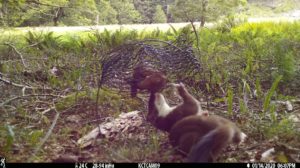
29 Jan - 1 February 2020
All cat trail cameras had their SD cards swapped and were set to a ‘dry round’ of monitoring in the East and West Matukituki Valleys.
The weather allowed for four catch sessions on Cascade track and three catch sessions at French Ridge Hut. A total of 17 kea were caught on this trip (12 on the Cascade Saddle track and five at French Ridge Hut).
Eight transmitters were fitted to adult kea (five males and three females). Bands were fitted to all birds caught and samples and measurements were recorded for the database.
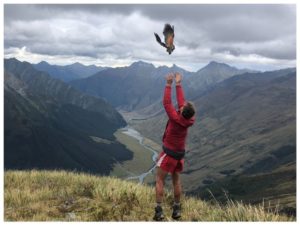
Monitoring outcomes of study kea through 1080 operation February 2020
A 1080 operation was carried out on the 10th-11th February 2020 by the Department of Conservation. A skyranger (remote tracking) flight carried out just prior to the drop on the 9th, found 10 of the 13 kea fitted with transmitters in the drop zone. Signals from the other 3 transmitters were not picked up at that time. It was later confirmed that a further 2 kea were within the operation area and 1 kea had chewed off its transmitter prior to the drop taking place (this was recovered at a later date). As such 12 out of the original 13 kea were ultimately confirmed as present and able to be monitored throughout the operation.
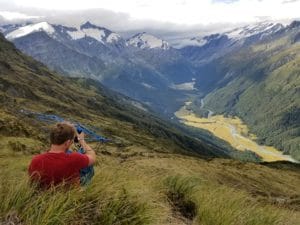
Tracking outcomes: A skyranger flight carried out on Thursday 13th Feb found 2 transmitter signals had switched to mortality mode. As a result, a person was sent in on the 14th and 15th to track down the signals to recover them to ascertain the bird's status (i.e. whether dead or a ditched transmitter). At this time neither transmitter was located however a further 3 mortality signals were picked up. Four birds were confirmed alive at this time.
A full team was sent in during the next fine weather window (19th and 20th Feb) and 6 dead adult kea and 1 dropped transmitter were recovered. Five kea were confirmed alive (either a signal or sighting returned), however, a signal could not be found for one female who had previously returned a signal on the 15th Feb. She was finally confirmed alive during an aerial tracking flight on the 18th Feb.
The recovered bodies were sent to Wildbase Hospital and Landcare Research for necropsy and toxicology testing. Results of testing confirm death from 1080 poisoning. All kea had previously been tested for lead and found to have low levels.
Where to from here?
1080 has been shown to benefit kea populations in some areas (particularly remote locations) by suppressing introduced mammals that kill nestlings however if adult survival through 1080 operations is 56.8 % or lower, the cost is likely to exceed the benefits of increased nest productivity in subsequent years.
So why do some populations, such as the Matukituki Valley kea, seem more at risk to picking up 1080 than others?
At-risk populations may include those kea that are habituated to people (in particular, hut birds and those kea being fed by people), or which have high blood lead levels (which may make them more likely to scrounge due to impaired cognitive function impacting on the ability to forage natural food sources). The Matukituki Valley birds fall into this first category. However, there may be other factors that put certain kea at higher risk (time of year, individual behaviour, cultural learning and food availability etc) and until these risk factors are identified, more funding and research needs to be focused to identify robust and cost-effective mitigation measures as well as ongoing monitoring of these populations through operations.
As such, we advocate the following measures urgently be adopted to minimise harm as follows:
Immediately:
- Review all current data to identify what makes a kea population at-risk;
- Identify and research other potential risk factors;
- Review all planned 1080 operations to identify which are likely to have at-risk kea populations.
For populations identified as at risk, operations should be postponed unless:
- Research and mitigation measures are researched and implemented;
- Survivorship is monitored and mitigation efficacy measured.
Trail camera outcomes January – December 2020
Data (SD) cards from all 16 trail cameras were swapped out every 6-8wks throughout 2020 (January, March, June, July, August) and camera data analysed.
In September – October these cameras were pulled out of both valleys and along with a further 8 cameras were reset to extend the study area.
Breeding season outcomes August – December 2020
This nesting season marks a milestone in the Matukituki kea threats monitoring. It is the first time any of our monitored females have been tracked to active nests. Isobel and Kia Kaha both nested this year!
A total of nine nest checks were undertaken between August and October to visually confirm nest statuses and change SD cards and batteries on cameras monitoring entrances and nest bowls at both nests. The nests were observed at all phases from eggs to young chicks to almost-fledged chicks. There were no predator incursions detected on the cameras and no sign of predator visits outside or inside both cavities. There is one more nest visit to be completed (November) to confirm the chicks have fledged and to remove nest cameras.
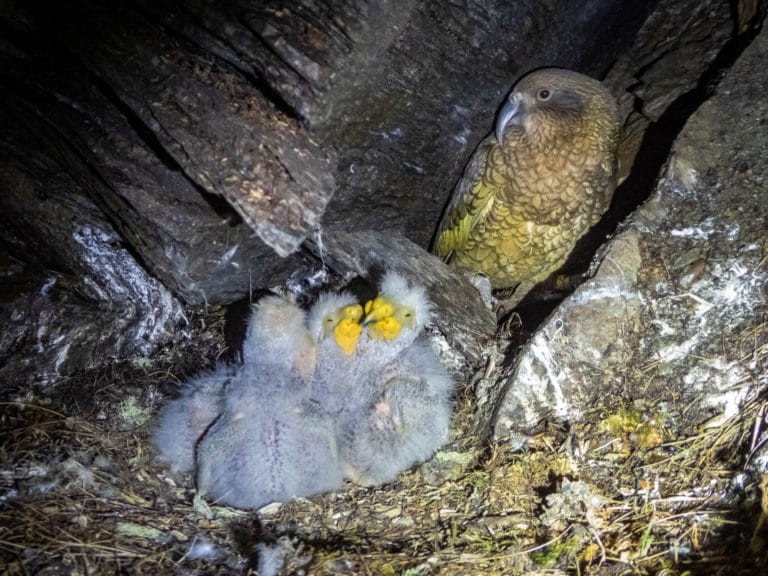
Isobel’s choice of nest marked another first for kea research. Her cavity is the first found in the alpine zone, about 150 metres above the treeline. Kea usually nest 100 – 200 m below the treeline in beech forest. Isobel was found to have 4 eggs in her nest and successfully hatched and raised 2 chicks.
Kia Kaha was found to have five eggs in her nest and successfully hatched and raised 4 chicks (photo above).
Nest protection efforts – trapping network
A line of ten traps was installed by a team of KCT and Matukituki Charitable Trust volunteers in September aimed at protecting Kia Kaha’s nest from pests approaching from the valley floor. This trapline was additional to an already existing trapline running along Cascade Track above the nest and to the DOC 1080 aerial predator control operation at the beginning of the year.
Traps were placed at a distance that was unlikely to attract predators to the nest. We would like to say a huge ‘thank you’ to the Matukituki Charitable Trust for providing the traps, helping install them, and regularly checking them. No predators have been caught in these traps to date.
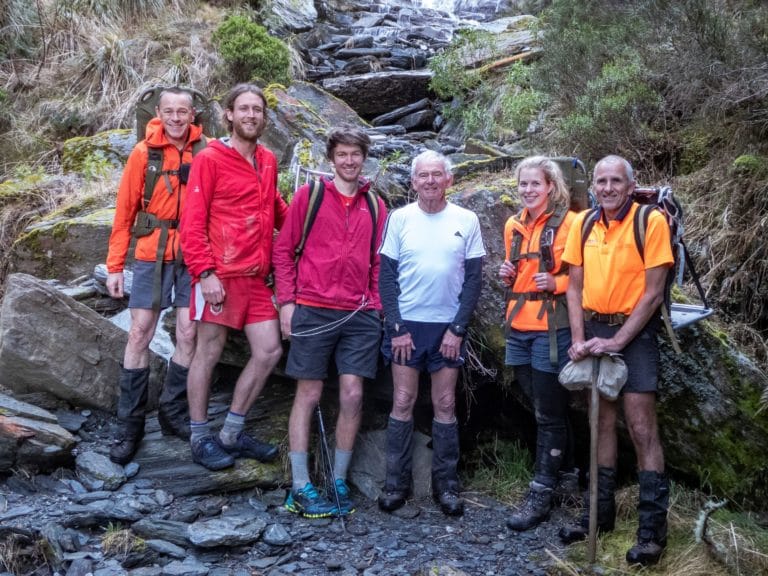
2019 Update
The status of the Matukituki kea population as of 2019 remains uncertain, however as no breeding activity has been recorded since monitoring began in 2016, few fledglings or juveniles have been sighted and local pest numbers appear high (as recorded by the Matukituki Charitable Trusts (MCT) pest control programme and DOC tracking tunnels) it appears likely that kea in the Matukituki may have been and continue to be suppressed as a result of multiple 1080 operations and a high numbers of mammalian pests. This area has received two 1080 drops to control introduced pests (2015 and 2017) however there seems to have been little positive impact on the kea population.
This 2nd year of this project attempts to understand whether predators (particularly large predators such as feral cats) are present higher up in the valleys by increasing the number of cameras deployed, to fit more transmitters to adult kea to monitor survival and to continue tracking breeding activity and fledging success (if any) across years.
A total of 52 kea have been caught and banded in the study area up to the end of 2019.